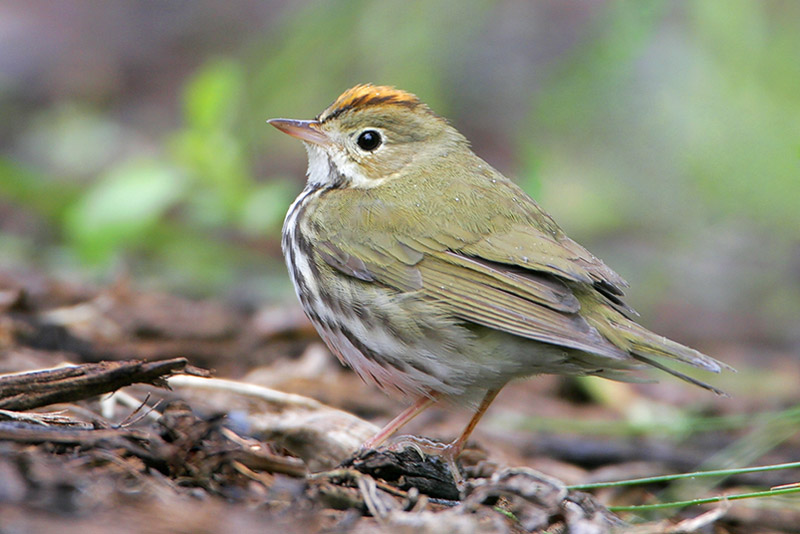The Ovenbird (Seiurus aurocapilla) is a small, terrestrial bird with spotted underparts, a bold eyering, and an orange stripe on its head.
Watch for this common warbler species in forest during the summer and in wooded parks and other green space during migration.
If you see a small olive bird steadily walking on the ground with spotted underparts and its tail held up, you have probably found an Ovenbird!
On this page
Identification
The Ovenbird is a small warbler with plain olive upperparts, and white underparts with black spots and streaks on its chest and flanks. This little bird also has a white eyering, a dark line on each side of its white throat, and a sharp, gray and pink beak.
On their head, Ovenbirds have an orange stripe bordered with black, right on the center of their crown. These birds also some olive coloration on their sides and lower flanks, and pink legs.
Unlike several other warblers, they don’t have any barring or markings on their wings or tail, and can look more like a small thrush than other members of the Parulidae.
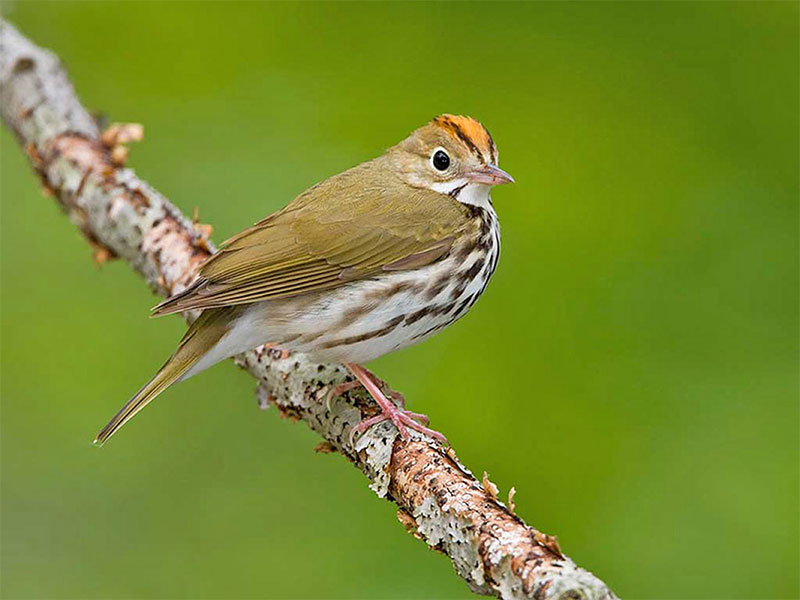
These birds are around the same size as a sparrow and are 6 inches in length, have a 9.5-inch wingspan, and weigh .68 ounces. We can also recognize them by their signature behavior of carefully walking on the forest floor as they hold their tail up.
Male and female Ovenbirds look the same, but only male birds sing their loud, staccato song. One of the more easily recognized bird songs, Ovenbirds repeat the same double-noted sound eight times. The song gets louder as the bird says, teacher teacher teacher teacher.
Both sexes also make a sharp chip note.
Food
Ovenbirds’ diet mostly consists of insects and other invertebrates. On their breeding grounds, this terrestrial bird eats a wide variety of small insects, bugs, and larvae.
Although they take all sorts of invertebrates, some of the more common prey items include ground beetles, larvae, and flies.
On their tropical wintering grounds, Ovenbirds have a similar diet, but they may eat more ants and seeds. At times, they can also take advantage of Army Ant swarms to catch small bugs that the predatory ants scare out of hiding.
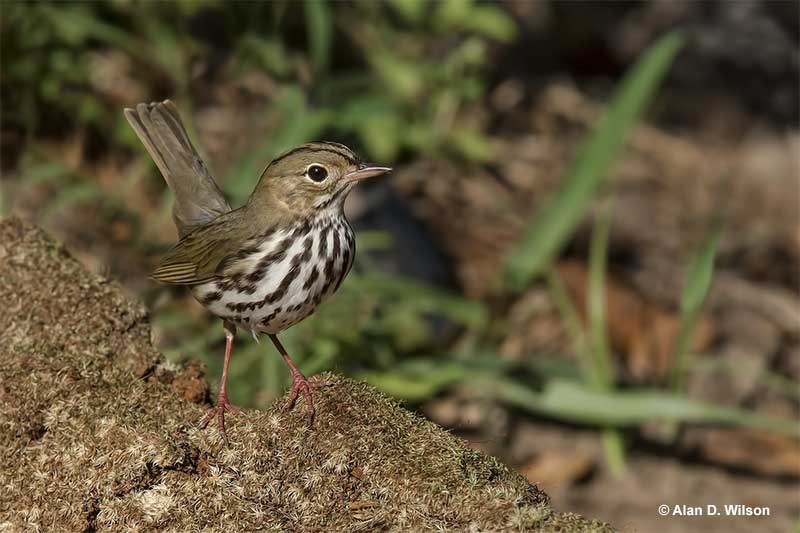
In general, this species takes advantage of whatever invertebrate food source happens to be most abundant. With that in mind, when they find a good food source, they tend to focus on that particular area until they have eaten most of the bugs.
No matter where they look for food, this warbler species typically forages by picking prey from leaves on the ground as it steadily walks through forest or shaded second growth. However, if they find trees with an abundance of caterpillar larvae, they can fly up into the foliage to feed on them.
Ovenbirds prefer shaded spots with plenty of leaf litter and almost never come into the open.
Nesting and Eggs
Ovenbirds come to their breeding grounds in May and females find mates a few days after arrival. Not long after, the female bird starts building her nest in a spot with a tall canopy, and often near a fallen tree or old, overgrown trail.
Her nest is also far from the edge of the forest and begins as a small, cleared spot on the ground. The female Ovenbird then uses grass, bark strips, and other dry plant matter to construct a small cup nest and lines it with deer or horse hair. The mother bird also makes a larger, dome-like structure over the nest to hide and protect it.
After five or six days, she finishes the dome by making a side entrance and placing dead leaves and other bits of vegetation on top so it just looks like part of the ground.
The female lays three to six, 0.79 inch long, pale eggs speckled with lavender and reddish-brown markings. After incubating them for 12 days, the eggs hatch and the male starts to help with nesting duties.
With both parents feeding the nestlings, they quickly grow and leave the nest seven to ten days after hatching.
The adults continue to feed their fledglings until the young birds are 30 days old and can take care of themselves.
Current Situation
Ovenbirds breed in large areas of mature forest in Canada from eastern British Columbia to Newfoundland, and in the USA from Montana to Maine and south to the southern Appalachians. The winter various tropical habitats from Florida and Mexico to northern South America.
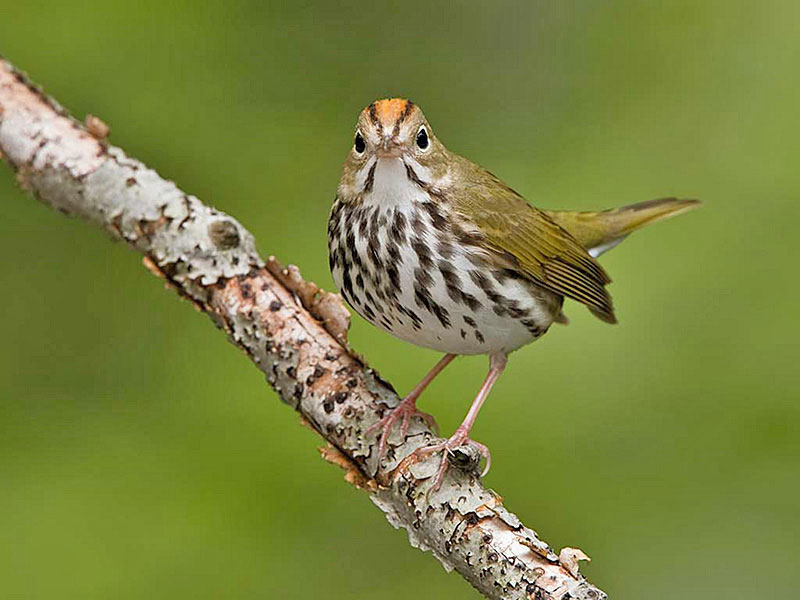
They are listed as Least Concern in the IUCN Red List and are believed to have a large, stable population of 26 million birds.
The Ovenbird is a common species with a large range but it is still very sensitive to logging and other types of changes to the mature forests it depends on.
Although Ovenbirds can use many habitats on their wintering grounds, this species requires large areas of intact forest on their breeding grounds. They are in danger of disappearing as a breeding species from fragmented forests and smaller woodlands.
Facts
- On their wintering grounds, Ovenbirds avoid competition with Swainson’s Warblers and the Kentucky Warbler by picking bugs from leaf litter. These other warbler species pick arthropods from low foliage or from underneath dead leaves.
- Although the Ovenbird is in the same family as the Yellow Warbler and other warbler species, it is not closely related to those birds and may be one of the first types of warblers to evolve.
- Like other ground-nesting birds, the Ovenbird has to be very careful of potential nest predators. To distract Chipmunks and other threats, female Ovenbirds act as if they are injured and try to lead the animal away from the hidden nest site.
- This species has been immortalized in literature by more than one author including in poems by Robert Frost and Robert Bly.
- Despite having a well-hidden nest, Ovenbirds that nest in fragmented forest are frequently parasitized by the Brown-headed Cowbird. They don’t recognize the cowbird as a threat and won’t try to drive it away from their territory. This is probably because, for much of their history, Ovenbirds lived in intact forests and didn’t come into contact with cowbirds and other species of open habitats.
Similar Species
The Ovenbird has a unique appearance. However, some of its field marks can remind us of a few other birds.
Hermit Thrush
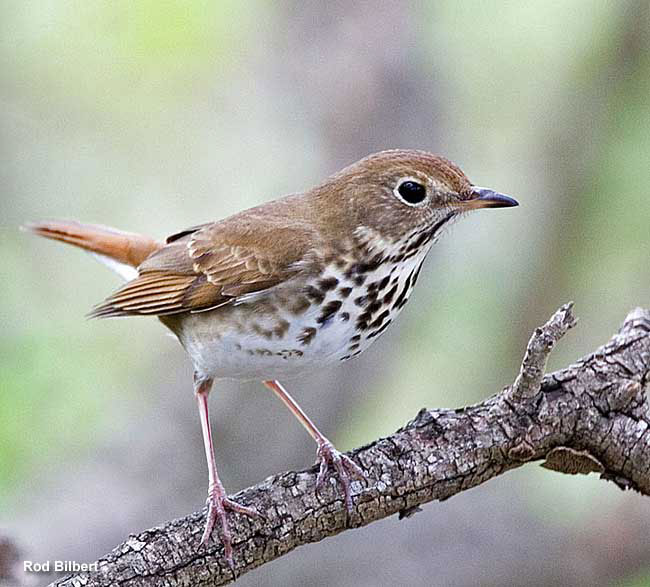
Hermit Thrushes are small thrush that also live on the ground and can look like an Ovenbird.
However, it has more of a broken eyering, is more brown than olive, and has a contrasting red-brown tail.
Swainson’s Thrush
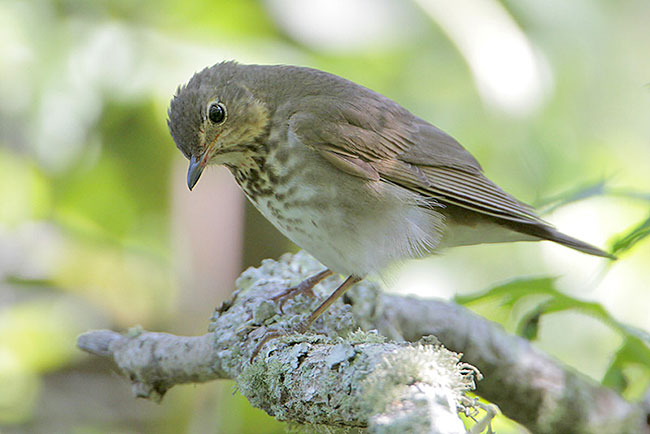
Ovenbirds are sometimes confused with Swainson’s Thrushes. To separate them, take a look at the eyering color, the front of the bird, and its overall color.
The Swainson’s Thrush has a buff eyering while the Ovenbird’s is white. The thrush also has buff on its face and breast, usually has more spotting below, and is more brown that olive.
Frequently Asked Questions
Why do they call it an Ovenbird?
They call it an Ovenbird because this species makes a dome-shaped nest with a side entrance that reminds people of an old fashioned, rounded oven.
What are Ovenbird noises?
Ovenbird noises include sharp chip notes and a loud song that consists of short, repeated phrases, “teacher, teacher, teacher, teacher!”.
What eats an Ovenbird?
Many animals eat Ovenbirds. Nestlings are eaten by Chipmunks, snakes, Raccoons, and other mammals. Adult Ovenbirds can be eaten by Sharp-shinned Hawks, owls, cats, and other predators.
Where do Ovenbirds live?
Ovenbirds live in forests in Canada, and in the eastern USA west to Montana and south to the Ozarks. They migrate throughout the eastern USA to winter from Florida, the Caribbean, and Mexico south to Venezuela.

